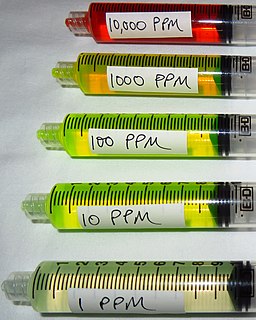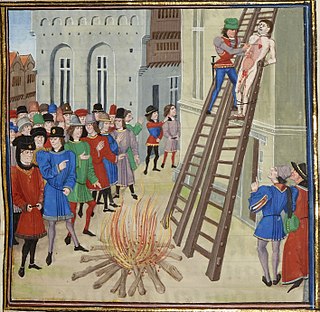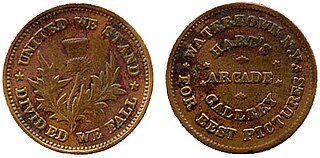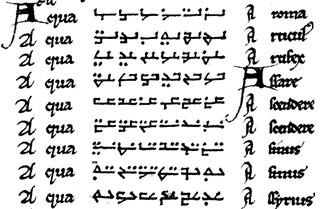Related Research Articles
The system of Hebrew numerals is a quasi-decimal alphabetic numeral system using the letters of the Hebrew alphabet. The system was adapted from that of the Greek numerals in the late 2nd century BCE.
A crore (; abbreviated cr), karor or koti denotes ten million (10,000,000 or 107 in scientific notation) and is equal to 100 lakh in the Indian numbering system. It is written as 1,00,00,000 with the local 2,2,3 style of digit group separators (one lakh is equal to one hundred thousand, and is written as 1,00,000).

In science and engineering, the parts-per notation is a set of pseudo-units to describe small values of miscellaneous dimensionless quantities, e.g. mole fraction or mass fraction. Since these fractions are quantity-per-quantity measures, they are pure numbers with no associated units of measurement. Commonly used are parts-per-million, parts-per-billion, parts-per-trillion and parts-per-quadrillion. This notation is not part of the International System of Units (SI) system and its meaning is ambiguous.

English number words include numerals and various words derived from them, as well as a large number of words borrowed from other languages.
A Hundred Thousand Billion Poems or One hundred million million poems (original French title: Cent mille milliards de poèmes) is a book by Raymond Queneau, published in 1961. The book is a set of ten sonnets printed on card with each line on a separate strip. As all ten sonnets have not just the same rhyme scheme but the same rhyme sounds, any lines from a sonnet can be combined with any from the nine others, allowing for 1014 (= 100,000,000,000,000) different poems. When Queneau ran into trouble creating the book, he solicited the help of mathematician Francois Le Lionnais, and in the process they initiated Oulipo.
This list contains selected positive numbers in increasing order, including counts of things, dimensionless quantity and probabilities. Each number is given a name in the short scale, which is used in English-speaking countries, as well as a name in the long scale, which is used in some of the countries that do not have English as their national language.

Nicolas Chuquet was a French mathematician. He invented his own notation for algebraic concepts and exponentiation. He may have been the first mathematician to recognize zero and negative numbers as exponents.
The Portuguese escudo was the currency of Portugal prior to the introduction of the euro on 1 January 1999 and the removal of the escudo from circulation on 28 February 2002. The escudo was subdivided into 100 centavos. The word escudo derives from the scutum shield.
-yllion is a proposal from Donald Knuth for the terminology and symbols of an alternate decimal superbase system. In it, he adapts the familiar English terms for large numbers to provide a systematic set of names for much larger numbers. In addition to providing an extended range, -yllion also dodges the long and short scale ambiguity of -illion.
Many languages have words expressing indefinite and fictitious numbers—inexact terms of indefinite size, used for comic effect, for exaggeration, as placeholder names, or when precision is unnecessary or undesirable. One technical term for such words is "non-numerical vague quantifier". Such words designed to indicate large quantities can be called "indefinite hyperbolic numerals".
This article lists and discusses the usage and derivation of names of large numbers, together with their possible extensions.

JeanFouquet (ca.1420–1481) was a French painter and miniaturist. A master of panel painting and manuscript illumination, and the apparent inventor of the portrait miniature, he is considered one of the most important painters from the period between the late Gothic and early Renaissance. He was the first French artist to travel to Italy and experience first-hand the early Italian Renaissance.
The Indian numbering system is used in the Indian subcontinent to express large numbers. The terms lakh (100,000) and crore (10,000,000) are the most commonly used terms to express large numbers in the system.
The long and short scales are two of several naming systems for integer powers of ten which use some of the same terms for different magnitudes.

Froissart's Chronicles are a prose history of the Hundred Years' War written in the 14th century by Jean Froissart. The Chronicles open with the events leading up to the deposition of Edward II in 1326, and cover the period up to 1400, recounting events in western Europe, mainly in England, France, Scotland, the Low Countries and the Iberian Peninsula, although at times also mentioning other countries and regions such as Italy, Germany, Ireland, the Balkans, Cyprus, Turkey and North Africa.

Civil War tokens are token coins that were privately minted and distributed in the United States between 1861 and 1864. They were used mainly in the Northeast and Midwest. The widespread use of the tokens was a result of the scarcity of government-issued cents during the Civil War.
Slang terms for money often derive from the appearance and features of banknotes or coins, their values, historical associations or the units of currency concerned. Within a language community, some of the slang terms vary in social, ethnic, economic, and geographic strata but others have become the dominant way of referring to the currency and are regarded as mainstream, acceptable language.
Historically Vietnamese has two sets of numbers: one is etymologically native Vietnamese; the other uses Sino-Vietnamese vocabulary. In the modern language the native Vietnamese vocabulary is used for both everyday counting and mathematical purposes. The Sino-Vietnamese vocabulary is used only in fixed expressions or in Sino-Vietnamese words. This is somewhat analogous to the way in which Latin and Greek numerals are used in modern English. Sino-Vietnamese words are also used for units of ten thousand or above, where native vocabulary was lacking.
A billion is a number with two distinct definitions:

The medieval Cistercian numerals, or "ciphers" in nineteenth-century parlance, were developed by the Cistercian monastic order in the early thirteenth century at about the time that Arabic numerals were introduced to northwestern Europe. They are more compact than Arabic or Roman numerals, with a single glyph able to indicate any integer from 1 to 9,999.
References
- ↑ Bibliothèque St Geneviève, Paris, MS Français 3143 - original French manuscript by Jehan Adam
- ↑ Jehan Adam, Traicté en arismetique pour la practique par gectouers… Parchemin. XVe siècle (1475).
- ↑ Lynn Thorndike, "The Arithmetic of Jehan Adam, A.D. 1475," Science and Thought in the Fifteenth Century